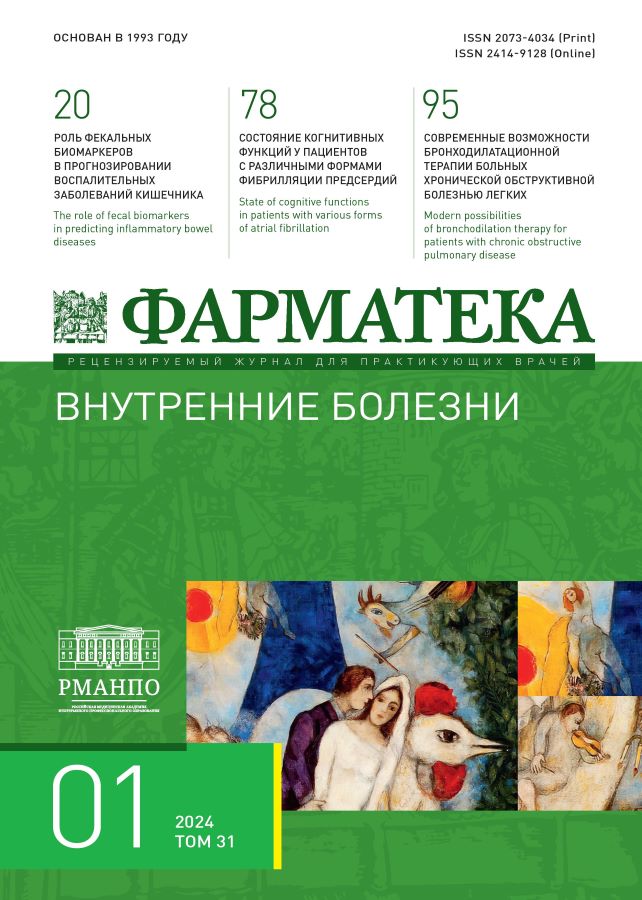Clinical effectiveness of early use of systemic antibacterial therapy for acne
- 作者: Perlamutrov Y.N.1, Olkhovskaya K.B.1, Lyapon A.O.1
-
隶属关系:
- University of Medicine
- 期: 卷 31, 编号 1 (2024)
- 页面: 178-182
- 栏目: Dermatology/allergology
- ##submission.datePublished##: 20.05.2024
- URL: https://journals.eco-vector.com/2073-4034/article/view/632305
- DOI: https://doi.org/10.18565/pharmateca.2024.1.178-182
- ID: 632305
如何引用文章
详细
Background. Activation of Cutibacterium acnes is one of the key links in the development of acne. Changes in the species composition of bacteria, increased enzymatic and pro-inflammatory activity determine the development of comedones, papules, pustules and other inflammatory elements. Early use of systemic antibiotics contributes to rapid and positive dynamics of the clinical symptoms of the disease, the formation of remission in a larger number of patients and an increase in the number of patients adherent to treatment.
Objective. Justification of the use of systemic antibiotics as initial therapy in patients with moderate acne.
Methods. We followed-up 60 patients (28/46.67% men and 32/53.33% women) with moderate to severe acne aged from 18 to 50 years (mean age 29.28±3.17 years). Patients were randomized into 2 comparison treatment groups. Group I consisted of 30 patients (12 men and 18 women) who received monotherapy using a gel whose active ingredient was a fixed combination of adapalene 1 mg/g and benzoyl peroxide 25 mg/g once a day for 28 weeks. Group II included 30 patients (16 men and 14 women) who were prescribed complex therapy using a fixed combination of adapalene 1 mg/g and benzoyl peroxide 25 mg/g once a day for 28 weeks and dispersible tablets of doxycycline monohydrate 100 mg 2 times a day for the first 4 weeks. All patients were recommended to use specialized cosmetics to care for problem skin throughout the entire course of treatment.
Results. It was found that initial therapy with the inclusion of an antibiotic increased the effectiveness of treatment. After completing the course of therapy, the number of patients with acne remission or excellent improvement in group II was 20 and 17% higher, respectively, than in the group receiving topical monotherapy.
Conclusion. A more rapid reduction in the activity of symptoms of moderate acne with the gradual use of systemic antibiotic therapy and topical treatment helps to increase patient’s adherence to therapy.
全文:
作者简介
Yu. Perlamutrov
University of Medicine
Email: olhovskaya_kira@mail.ru
ORCID iD: 0000-0002-4837-8489
SPIN 代码: 2330-2758
Department of Skin and Venereal Diseasesn
俄罗斯联邦, MoscowKira Olkhovskaya
University of Medicine
编辑信件的主要联系方式.
Email: olhovskaya_kira@mail.ru
ORCID iD: 0000-0003-4920-5288
SPIN 代码: 9455-9482
Cand. Sci. (Med.), Associate Professor at the Department of Skin and Sexually Transmitted Diseasesn
俄罗斯联邦, MoscowA. Lyapon
University of Medicine
Email: olhovskaya_kira@mail.ru
ORCID iD: 0000-0002-7762-6410
Department of Skin and Venereal Diseasesn
俄罗斯联邦, Moscow参考
- Huang C., Zhuo F., Han B., et al. The updates and implications of cutaneous microbiota in acne. Cell Biosci. 2023;13:113.
- Hooper, L.V., Littman, D.R., Macpherson, A.J. Interactions between the microbiota and the immune system. Science. 2012;336: 1268–73.
- Giurgiu G., Cojocaru M. New insights into skin microbiota in acne pathophysiology. Ann Romanian Soc Cell Biol. 2021;10:12–8.
- Davidsson S., Molling P., Rider J.R., et al. Frequency and typing of Propionibacterium acnes in prostate tissue obtained from men with and without prostate cancer. Infect Agents Cancer. 2016;11:26.
- Schupp J.C., Tchaptchet S., Lutzen N., et al. Immune response to Propionibacterium acnes in patients with sarcoidosis in vivo and in vitro. BMC. Pulm Med. 2015;15:75.
- Yamamoto R., Miyagawa S., Hagiya H., et al. Silent Native-valve Endocarditis Caused by Propionibacterium acnes. Intern Med. 2018;57(16):2417–20.
- Achermann Y., Goldstein E.J.C., Coenye T., et al. Propionibacterium acnes: from commensal to opportunistic biofilm-associated implant pathogen. Clin Microbiol Rev. 2014; 27(3):419–40.
- Thiboutot D.M., Dreno B., Abanmi A., et al. Practical management of acne for clinicians: an international consensus from Global Alliance to improve outcomes in acne. J. Am. Acad. Dermatol. 2018;78(2 Suppl. 1):S1–23.
- Doshi A., Zaheer A., Stiller M.J. A Comparison of Current Acne Grading Systems and Proposal of a Novel System. Int J Dermatol. 1997;36:416–18.
- Morisky D.E., Green L.W., Levine D.M. Concurrent and Predictive Validity of a Self-reported Measure of Medication Adherence. Med Care. 1986;24(1):67–74.
- Saint-Leger D., Bague A., Cohen E., Chivot M. A possible role for squalene in the pathogenesis of acne. I. In vitro study of squalene oxidation. Br J Dermatol. 1986;114:535–42.
- Padmavathi R., Rajamannan B., Gunasekaran S., et al. Squalene Role in the Pathogenesis of Acne Vulgaris. J Clin Exp Dermatol Res. 2021;Suppl. 13:586.
- Tan J., Beissert S., Cook-Bolden F., et al. Evaluation of psychological wellbeing and social impact of combined facial and truncal acne: a multi-national, mixed-methods study. Dermatol Ther (Heidelb). 2022;12(8):1847–58.
- Isard O., Knol A.C., Aries M.F., et al. Propionibacterium acnes activates the IGF-1/IGF-1R system in the epidermis and induces keratinocyte proliferation. J Investig Dermatol. 2011;131:59–66.
- Mouser P.E., Baker B.S., Seaton E.D., Chu A.C. Propionibacterium acnes-reactive T helper-1 cells in the skin of patients with acne vulgaris. J Investig Dermatol. 2003;121:1226–28.
- Akamatsu H., Tomita T., Horio T. Effects of roxithromycin on the production of lipase and neutrophil chemotactic factor by Propionibacterium acnes. Dermatol. 2002;204: 277–80.
- Gehring M., Wieczorek D., Kapp A., Wedi B. Potent Anti-Inflammatory Effects of Tetracyclines on Human Eosinophils. Front Allergy. 2021;2:754501.
- Федеральные клинические рекомендации по ведению больных акне. М., 2016. 10 с. [Federal clinical guidelines for the management of acne patients. M., 2016. 10 p. (In Russ.)].
- Nast A., Dreno B., Bettoli V., et al., European Evidence-based (S3) Guidelines for the Treatment of Acne. J Eur Acad Dermatol Venereol. 2016;30(8):1261–68.








